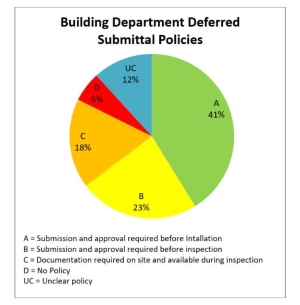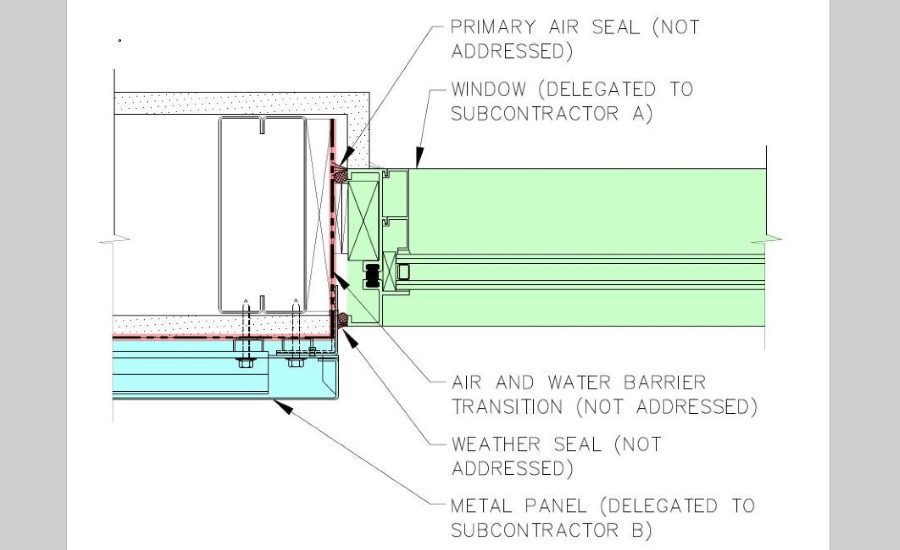Delegated design encompasses portions of a design that are to be completed by the contractor or its subcontractors. Typically these include specialty systems and components including, but not limited to, precast concrete components and curtain wall systems. Delegated design can be appealing due to reduced costs, improved schedules, and the expert knowledge possessed by specialty designers. However, lines between the design and contractual responsibilities of the licensed designer of record (prime) and delegated designers often become blurred.
This confusion can lead to problems during construction and disputes over who is liable for flaws or failures. To add further ambiguity, licensing boards are also inconsistent in how they view the responsibilities of prime versus delegated designers, and building departments vary widely in their approval processes for delegated designs. Luckily, proper specifications can provide clarity regarding design responsibility and submittal requirements. Throughout this article, the authors will discuss the promises and perils of delegated design, and highlight ways for building envelope professionals to promote a complete and code conforming final product.
Licensure Laws
At a surface level, the term “delegated design” implies the shifting of responsibility, and therefore liability, for the designed element from the prime to the delegated designer. Some states, notably Florida and New York, encourage this mindset and explicitly promote the delegated design process. However, this is not always the case. Missouri and Mississippi, for example, do not allow the project design professional of record to delegate responsibility.
In these states, the liability for any problems arising around a “delegated” design element remains with the prime designer. Whether or not they maintain a hard policy for delegated design, all states require licensed design professionals to hold paramount the health, safety, and welfare of the public. Their responsibility to the public should guide how the prime designer approaches the delegated design process.
Recommendations:
- Both prime and delegated designers should understand local laws and know who is responsible for the final design from a legal standpoint.
- Regardless of whether or not the prime designer retains liability for the design, their responsibility to hold paramount public safety means that they should never treat the submittal and review process for delegated designs lightly.
Coordination and Contractual Relationships
According to standard AIA contract language, Contractors only have a duty to provide architectural or engineering design services when specifically required by the contract documents. Where these services are required, all performance and design criteria must be specified by the project designer of record.
The standard contract language also states that the project designer of record is only required to check submittals for conformance with information given and the design concepts expressed in the contract documents. Therefore, typical specifications for a delegated design include performance requirements for the delegated item. But are the typical specifications sufficient to prevent problems?
Where some, but not all components of a building envelope are delegated, there are naturally interfaces between delegated items and neighboring components which may be delegated to a different specialty designer or designed by the prime designer. For example, consider the case of a metal panel cladding system and adjacent windows whose designs are delegated to separate entities (Figure 1). Suppose the construction documents are clear as to who is responsible for the design of each component, but neglect to mention the interfaces in between. Both delegated designers may indicate “seals to be designed by others” in their respective shop drawings. The lack of a complete design could result in a leaky building.
Another common problem can arise when the prime designer delegates the design for a curtain wall system and its connections to the primary structure (Figure 2). The construction documents may list typical performance requirements and design criteria, including deflection limits and anticipated loads. But, if the prime designer assumes that the curtain wall gravity loads will be supported by the primary structure at each floor, while the delegated designer assumes every other floor, there could be a serious impact on the structural system of the building as a whole.

Figure 2
When omissions and inconsistencies in the design aren’t caught until the construction phase or after building occupancy, they lead to delays, added costs, and in some cases accidents and loss of life; all of which result in conflict over who is at fault. Additionally, if the owner was not aware that the project included delegated design elements, the prime designer’s lack of transparency could cause a misunderstanding and loss of rapport with their client.
Recommendations:
- The prime designer should be up-front with the owner regarding what delegated design is, which elements of the project will have delegated designs, the risks involved, and how the delegated design process can benefit the owner.
- The contract documents should clearly state who is responsible, not only for each portion of the design, but also for the interfaces between elements to be designed by different parties.
- As part of the performance requirements and design criteria, the contract documents should clearly state all assumptions that could affect the design of delegated elements.
- The prime designer should use the submittal and review process to check that all parts of the design are completed by a duly licensed professional and conform to the prime designer’s specified performance requirements, design criteria, and design assumptions.
- The flow of information should be restricted by formal relationships (as shown in Figure 3). Submittals should be sent from the specialty designer through the subcontractors and GC before reaching the prime designer and reviewed documents should be sent back through the same channels. Finalized design submittals should also be sent to the building department for review, as discussed in the following section. This ensures that all parties are aware of the approval status and any design decisions or changes that could affect other areas of the project.

Figure 3
Building Codes and Building Departments
From a building department perspective, delegated designs are often handled through deferred submittals. The IBC defines a deferred submittal as “those portions of the design that are not submitted at the time of the application [for permit] and that are submitted to the building official within a specified period.” Per Section 107.3.4.1 of the IBC, the prime designer is required to list deferred submittals on the construction documents for prior approval from the building official.
Once complete, deferred submittal documents must be received and approved by first the prime designer and then the building department prior to installation of the deferred items. Despite the clear framework given in the IBC, the approval processes that local building departments use in practice are inconsistent. The authors inquired into the procedures followed by building departments throughout the United States (responses are summarized in Figure 4).

Figure 4
Of the building departments responding, only about 40 percent require deferred submittals be received and approved by the designer of record and the building official prior to installation. Due to a lack of time and resources, some building departments do not review deferred submittals at all. In these jurisdictions, if the designer of record does not review the submittals themselves, key building components might be installed without any verification that the design was prepared by a duly licensed design professional and conforms to the project requirements.
Recommendations:
- Regardless of local building department policy, the prime designer should always require AND review stamped/sealed design submittals. Additionally, the construction and/or installation of delegated items should always be held until after their design is approved by both the prime designer and the Building Official.
Concluding Remarks
Fortunately, when all parties are well informed and proper precautions are taken, the delegated design process can benefit everyone involved. Due to reduced design responsibilities, the prime designer is able to offer more competitive design fees, appropriately assign these design responsibility to a specialist and take on a higher volume of projects.
By focusing on one particular building system, specialty designers become experts in their fields and are capable of delivering a higher quality final product for their portion of the project. And because they are involved in the design from the beginning the contractor is able to operate on an abbreviated construction schedule. Each step of the way the owner benefits from reduced costs, improved quality, and saved time.



